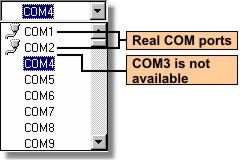Choosing the VSP Name
This topic provides additional information on choosing a proper VSP name.
There are no rules on what VSP name to choose, just make sure that you pick the name that can be selected in the application software you plan to use with this VSP . Most programs provide a limited selection of ports (typically, up to COM2 or COM4). Therefore, choosing "COM100" won't be suitable as you will not be able to select this VSP in such a program.

On the screenshot above COM3 is not listed- this is because the VSP with this name already exists. Notice, however, that ports COM1 and COM2 are not excluded from the list and are marked with icons identifying them as "real" COMs*. This is because even though these port numbers are "occupied" the Connection Wizard can still "grab" them. For example, if you select COM1 the Wizard will automatically reassign COM1 to be a VSP (from this moment on COM1 will cease working as a normal COM port and will start working as a VSP ). Substitution may be necessary when you are dealing with an old application software that only provides a choice of COM1 and COM2 which are usually occupied by real COMs.
When you delete the VSP (this can be done through the VSP Manager ) that substituted a standard COM port the VSP Manager will attempt to restore the original driver (make this port become a normal COM again). This mostly works but on some systems you may encounter problems (especially under Windows ME ). We have conducted an extensive "research" into the port substitution, only to conclude that it just won't work reliably on all systems!
We recommend that you do not use port substitution unless absolutely necessary!
|
* This is system-dependent. Some modern PCs don't have any real COMs.